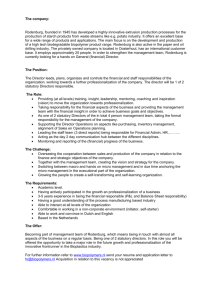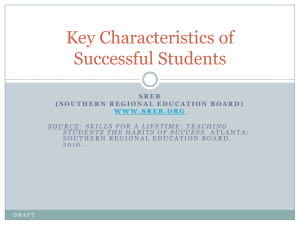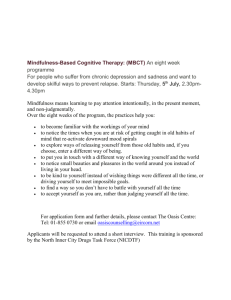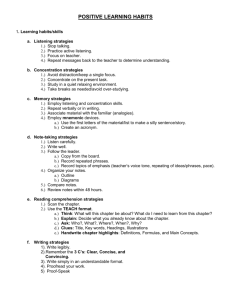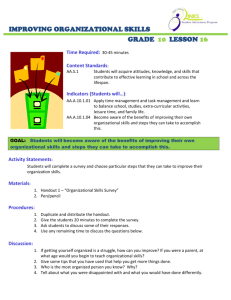Elsa
advertisement
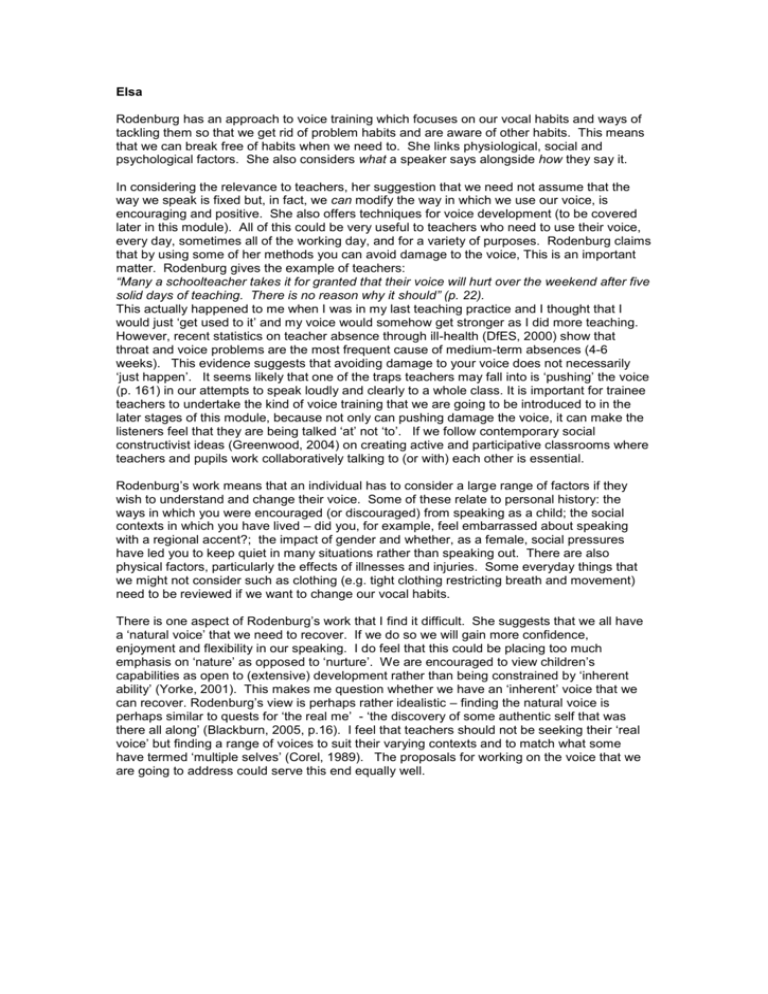
Elsa Rodenburg has an approach to voice training which focuses on our vocal habits and ways of tackling them so that we get rid of problem habits and are aware of other habits. This means that we can break free of habits when we need to. She links physiological, social and psychological factors. She also considers what a speaker says alongside how they say it. In considering the relevance to teachers, her suggestion that we need not assume that the way we speak is fixed but, in fact, we can modify the way in which we use our voice, is encouraging and positive. She also offers techniques for voice development (to be covered later in this module). All of this could be very useful to teachers who need to use their voice, every day, sometimes all of the working day, and for a variety of purposes. Rodenburg claims that by using some of her methods you can avoid damage to the voice, This is an important matter. Rodenburg gives the example of teachers: “Many a schoolteacher takes it for granted that their voice will hurt over the weekend after five solid days of teaching. There is no reason why it should” (p. 22). This actually happened to me when I was in my last teaching practice and I thought that I would just ‘get used to it’ and my voice would somehow get stronger as I did more teaching. However, recent statistics on teacher absence through ill-health (DfES, 2000) show that throat and voice problems are the most frequent cause of medium-term absences (4-6 weeks). This evidence suggests that avoiding damage to your voice does not necessarily ‘just happen’. It seems likely that one of the traps teachers may fall into is ‘pushing’ the voice (p. 161) in our attempts to speak loudly and clearly to a whole class. It is important for trainee teachers to undertake the kind of voice training that we are going to be introduced to in the later stages of this module, because not only can pushing damage the voice, it can make the listeners feel that they are being talked ‘at’ not ‘to’. If we follow contemporary social constructivist ideas (Greenwood, 2004) on creating active and participative classrooms where teachers and pupils work collaboratively talking to (or with) each other is essential. Rodenburg’s work means that an individual has to consider a large range of factors if they wish to understand and change their voice. Some of these relate to personal history: the ways in which you were encouraged (or discouraged) from speaking as a child; the social contexts in which you have lived – did you, for example, feel embarrassed about speaking with a regional accent?; the impact of gender and whether, as a female, social pressures have led you to keep quiet in many situations rather than speaking out. There are also physical factors, particularly the effects of illnesses and injuries. Some everyday things that we might not consider such as clothing (e.g. tight clothing restricting breath and movement) need to be reviewed if we want to change our vocal habits. There is one aspect of Rodenburg’s work that I find it difficult. She suggests that we all have a ‘natural voice’ that we need to recover. If we do so we will gain more confidence, enjoyment and flexibility in our speaking. I do feel that this could be placing too much emphasis on ‘nature’ as opposed to ‘nurture’. We are encouraged to view children’s capabilities as open to (extensive) development rather than being constrained by ‘inherent ability’ (Yorke, 2001). This makes me question whether we have an ‘inherent’ voice that we can recover. Rodenburg’s view is perhaps rather idealistic – finding the natural voice is perhaps similar to quests for ‘the real me’ - ‘the discovery of some authentic self that was there all along’ (Blackburn, 2005, p.16). I feel that teachers should not be seeking their ‘real voice’ but finding a range of voices to suit their varying contexts and to match what some have termed ‘multiple selves’ (Corel, 1989). The proposals for working on the voice that we are going to address could serve this end equally well.

